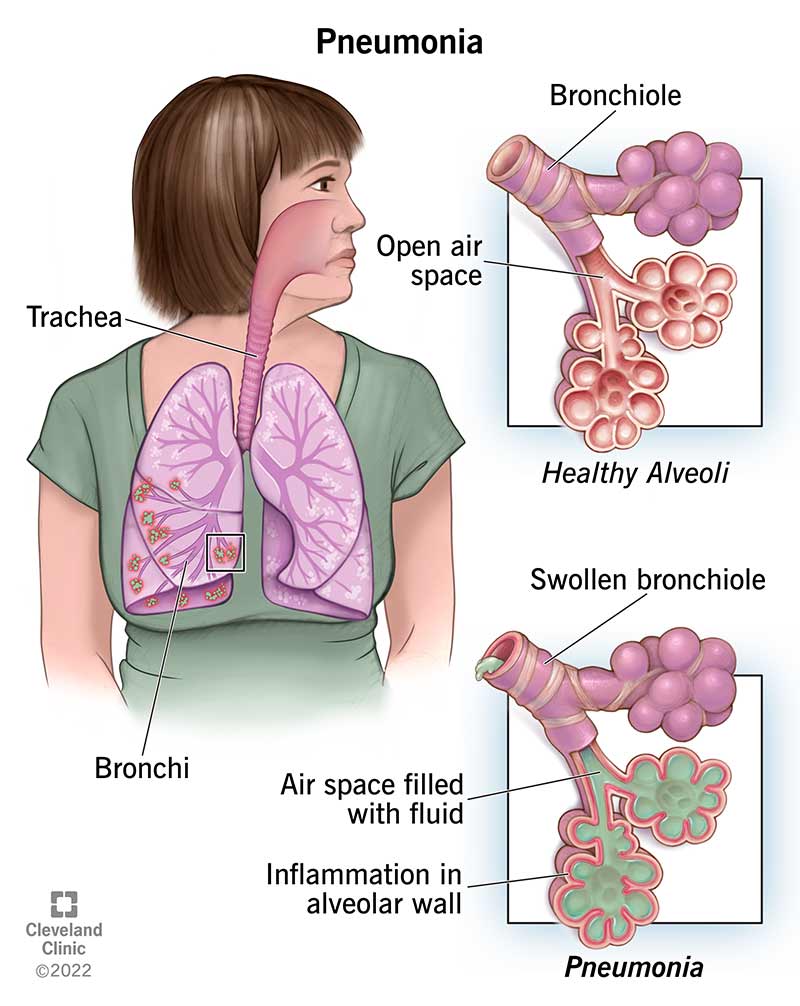An overview of Pneumonia
What is Pneumonia?
Pneumonia is an infection that inflames the air sacs in one or both lungs. The airsacs may fill with fluid or pus (purulent material), causing cough with phlegm orpus, fever, chills, and difficulty breathing. A variety of organisms, includingbacteria, viruses and fungi, can cause pneumonia.
Pneumonia can range in seriousness from mild to life-threatening. It is most seriousfor infants and young children, people older than age 65, and people with healthproblems or weakened immune systems. Pneumonia can affect one or both lungs.Pneumonia in both of your lungs is called bilateral or double pneumonia.

Types of pneumonia?
Bacterial pneumonia : Many bacterial strains can cause pneumonia, but the mostcommon is Streptococcus pneumoniae (S. pneumoniae). A doctor may refer to pneumoniaresulting from this strain as pneumococcal pneumonia.
Viral pneumonia : Viral causes of pneumonia include the respiratory syncytialvirus and influenza types A and B.
Fungal pneumonia : This can result from a condition such as valley fever,caused by the Coccidioides fungus.
Aspiration pneumonia : This type occurs as a result of inhaling food, liquids,or stomach contents into the lungs. Aspiration pneumonia is not contagious.
Hospital-acquired pneumonia : This can occur in people receiving hospitaltreatment for other conditions that involve use of a respirator or breathingmachine.
Causes of pneumonia
Pneumonia is typically due to infectious pathogens, such as bacteria and viruses.These pathogens can spread via coughing and sneezing or by contaminating surfacesthat people touch.
In most cases, a person contracts pneumonia-causing pathogens by breathing them intothe small air sacs, or alveoli, within their lungs. The immune system responds bysending white blood cells to attack the infection, which triggers inflammation ofthe alveoli. The alveoli fill with fluid and pus, causing pneumonia.
Signs and symptoms of pneumonia
The signs and symptoms of pneumonia vary from mild to severe, depending on factorssuch as the type of germ causing the infection, and your age and overall health.Mild signs and symptoms often are similar to those of a cold or flu, but they lastlonger.
Signs and symptoms of pneumonia may include:
1. Chest pain when you breathe or cough
2. Confusion or changes in mental awareness (in adults age 65 and older)
3. Cough, which may produce phlegm
4. Fatigue
5. Fever, sweating and shaking chills
6. Lower than normal body temperature (in adults older than age 65 and people withweak immune systems)
7. Nausea, vomiting or diarrhea
8. Shortness of breath
How can I prevent pneumonia?
The best way to prevent pneumonia is to get vaccinated against bacteria and virusesthat commonly cause it. There are also everyday precautions you can take to helpreduce your risk of pneumonia.
How is pneumonia diagnosed?
To diagnose pneumonia, a healthcare provider will ask about your health history andconduct a physical exam. They’ll listen to your lungs with a stethoscope and mayperform or order additional tests. These include imaging (like chest X-rays), pulseoximetry (checking oxygen levels in your blood), blood tests or sputum (spit) tests.
Even if your healthcare provider confirms that you have pneumonia, sometimes, theycan’t find the exact cause.
How is pneumonia treated?
Treatment for pneumonia depends on the cause — bacterial, viral or fungal — and howserious your case is. In many cases, the cause can’t be determined and treatment isfocused on managing symptoms and making sure your condition doesn’t get worse.
Some treatments may include:
Antibiotics : Antibiotics treat bacterial pneumonia. They can’t treat a virusbut a provider may prescribe them if you have a bacterial infection at the same timeas a virus.
Antifungal medications : Antifungals can treat pneumonia caused by a fungalinfection.
Antiviral medications : Viral pneumonia usually isn’t treated with medicationand can go away on its own. A provider may prescribe antivirals such as oseltamivir(Tamiflu®), zanamivir (Relenza®) or peramivir (Rapivab®) to reduce how long you’resick and how sick you get from a virus.
Oxygen therapy : If you’re not getting enough oxygen, a provider may give youextra oxygen through a tube in your nose or a mask on your face.
IV fluids : Fluids delivered directly to your vein (IV) treat or preventdehydration.
Draining of fluids :If you have a lot of fluid between your lungs and chestwall (pleural effusion), a provider may drain it. This is done with a catheter orsurgery.
Frequently Asked Questions About pneumonia
Viral pneumonia often goes away on its own, but youshould always follow your healthcare provider’s recommendationsto treat symptoms and reduce your risk of serious complications.
If you have bacterial pneumonia, you’re no longerconsidered contagious when your fever is gone and you’ve been onantibiotics for at least two days. If you have viral pneumonia,you’re still considered contagious until you feel better andhave been free of fever for several days.
Anyone can get pneumonia. It’s a common illness, withmillions of people diagnosed each year in the United States.About 55,000 people die each year of pneumonia in the U.S. It’sthe most common cause of death in developing countries.
Pneumonia itself isn’t actually contagious, but thebacteria and viruses that cause it are. For instance, the flu iscontagious and can lead to pneumonia, but most people who getthe flu won’t get pneumonia.The bacteria that most commonlycauses pneumonia, Streptococcus pneumoniae, can be spread fromperson to person by touching infected surfaces or throughcoughing and sneezing.